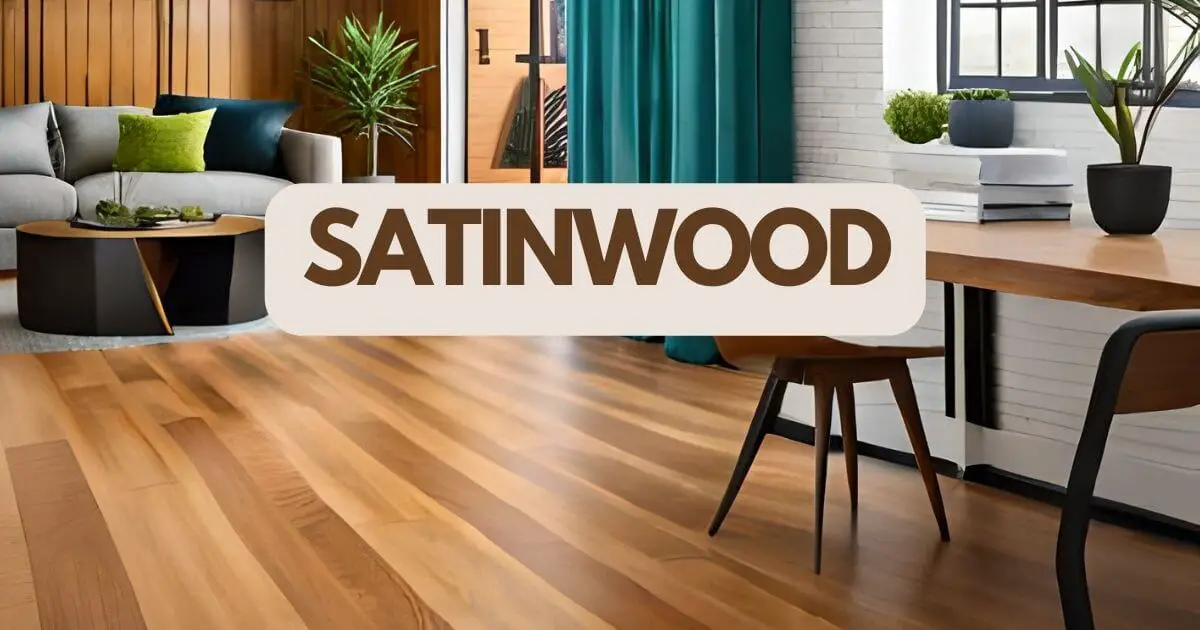Satinwood is a hard and durable wood prized for its yellowish-brown appearance and various uses. It is also called Ceylon satinwood. Satinwood comes from the small to medium size Satinwood tree.
There have been only two major species of satinwood: East Indian Satinwood (Chloroxylon swietenia) and West Indian Satinwood (Zanthoxylum flavum). East Indian Satinwood is native to Sri Lanka and India, and West Indian Satinwood is native to Africa and South America.
Characteristic of Satinwood
| Scientific name | Zanthoxylum flavum |
| Tree Size | 30-40 ft (9-12 m) tall, 1-1.5 ft (30-46 cm) trunk diameter |
| Average Dried Weight: | 56 lbs/ft3 (900 kg/m3) |
| Specific Gravity (Basic, 12% MC): | 0.71, 0.90 |
| Janka Hardness: | 1,820 lbf (8,100 N) |
| Rot-resistant | Moderalty |
| Hardness | Very Hard |
| Type | Hardwood |
Wood Appearance
The heartwood of satinwood can vary in color from deep golden-yellow to orange-brown, often with dark brown or orange streaks, and the sapwood is usually a pale yellow or cream color. The color of satinwood wood can vary depending on the specific species.
Satinwood has an interlocked or irregular grain, a fine and even texture with a very high natural luster.
Does Satinwood Change Color Over Time?
Like other woods, satinwood also darkens over time, particularly when exposed to light. Color change in satinwood depends on many factors, such as the specific species, the finish or protective coating applied to the wood, and the amount of light.
Common Uses of Satinwood
Satinwood is mainly used for fine furniture, inlay, decorative items, turnings, and veneer. Because satinwood is a strong and durable hardwood species, it is suitable for almost all indoor wooden projects.
Satinwood Pros and Cons
Satinwood is an excellent hardwood for many purposes but has some drawbacks. Here are the pros and cons of satinwood:
Pros
- Beautiful Appearance: Satinwood is popular for its smooth and shiny appearance, making it unique. It has a fine texture, and attractive grain patterns make it a popular choice for interior projects.
- Durable: Satinwood is a durable hardwood that can withstand wear and tear. Being extremely hard, it is resistant to scratches and dents, making it an excellent option for flooring.
- Stability: Satinwood is relatively stable and less prone to warping, shrinking, etc. It is a good choice for applications exposed to moisture and weather.
- Easy to finish: Satinwood can be easily finished. It gives excellent results after finishing.
Cons
- Expensive: Satinwood is considered an expensive hardwood because of its high-quality and limited availability.
- Availability: Satinwood is not as readily available as some other hardwoods. It is mainly obtained from tropical regions.
- Hard to work: Satinwood is difficult to work with as it is very hard and dense. Due to the high oil content, it can occasionally cause problems with gluing.
Working With Satinwood
All species of satinwood are difficult to work with because they are very hard and dense, which dulls the blade quickly. Its irregular grain pattern also creates difficulties during planing. Overall, Working with satinwood can be more challenging for a beginner.
Hardness
Satinwood is an extremely hard wood species. East Indian Satinwood has a Janka Hardness of 2,620 lbf (11,650 N), and West Indian Satinwood has a Janka Hardness of 1,820 lbf (8,100 N). Satinwood is harder than mahogany, maple and cedar.
Here is the Janka hardness of some popular wood species to give you an idea of how hard satinwood is.
| Wood species | Janka Hardness |
| Honey Locust | 1,580 lbf (7,030 N) |
| Pacific Yew | 1,600 lbf (7,120 N) |
| West Indian Satinwood | 1,820 lbf (8,100 N) |
| Merbau | 1,840 lbf (7,620 N) |
| Wenge | 1,930 lbf (8,600 N) |
| East Indian Ebony | 2,430 lbf (10,790 N) |
| East Indian Satinwood | 2,620 lbf (11,650 N) |
| Jatoba | 2,690 lbf (11,950 N) |
| Bloodwood | 2,900 lbf (12,900 N) |
| Cocobolo | 2,960 lbf (14,140 N) |
Is Satinwood Good For the Outdoor?
No, Satinwood is not considered suitable for outdoor use as it is not resistant to insects and weather. Wood tends to deteriorate quickly when exposed to moisture or soil. If we do proper sealing or finishing, it can withstand the weather for a short time but not for a long time.
Is Satinwood Good For the furniture?
Yes, Satinwood is an excellent choice for indoor furniture. It is a very durable and stable hardwood. Satinwood furniture requires low maintenance and care.
Is Satinwood Lumber Good Cutting Boards?
Yes, Satinwood can be used for cutting boards. It is completely safe to use as a cutting board. Due to its sufficient hardness, it can withstand knife blows and moisture. But Satinwood is not a popular wood for cutting boards. Maple, Cherry, and Walnut are the most popular wood species for cutting boards.
Is Satinwood Allergenic Wood?
Satinwood has been reported as a sensitizer. Therefore, while working with it, you may have problems like irritation in the eyes and skin. So be careful while working, and wear glasses and goggles to protect yourself.
Read Also: Satinwood vs Mahogany Wood

